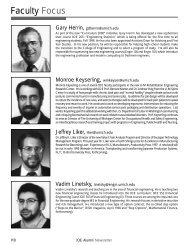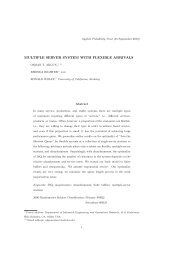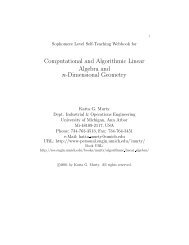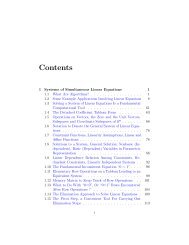Chapter 1 LINEAR COMPLEMENTARITY PROBLEM, ITS ...
Chapter 1 LINEAR COMPLEMENTARITY PROBLEM, ITS ...
Chapter 1 LINEAR COMPLEMENTARITY PROBLEM, ITS ...
You also want an ePaper? Increase the reach of your titles
YUMPU automatically turns print PDFs into web optimized ePapers that Google loves.
44 <strong>Chapter</strong> 1. Linear Complementarity Problem, Its Geometry, and Applications<br />
For this game, it can be veri ed that the probability vectors (x =(1 0) T y =(1 0) T ).<br />
(^x = (0 1) T ^y = (0 1) T ) are both equilibrium pairs. The losses from the two equilibrium<br />
pairs (x y), (^x ^y) are distinct, (x y) will be preferred by player I, whereas II<br />
will prefer (^x ^y). Because of this, these equilibrium pairs are unstable. Even if player<br />
Iknows that II will use the strategy ^y, shemay insist on using strategy x rather than<br />
^x, hoping that this will induce II to switch to y. So, in this game, it is di cult to<br />
foresee what will happen. The probability vectors (~x =(4=5 1=5) ~y =(1=5 4=5) T )is<br />
another equilibrium pair. In this problem, knowledge of these equilibrium pairs seems<br />
to have contributed very little towards the development of any \optimum" strategy.<br />
Even though the theory of equilibrium strategies is mathematically elegant, and<br />
algorithms for computing them (through the LCP formulation) are practically e cient,<br />
they have not found many real world applications because of the problems with them<br />
illustrated in the above examples.<br />
1.5 OTHER APPLICATIONS<br />
Besides these applications, LCP has important applications in the nonlinear analysis of<br />
certain elastic-plastic structures such as reinforced concrete beams, in the free boundary<br />
problems for journal bearings, in the study of nance models, and in several other<br />
areas. See references [1.1 to 1.5, 1.8, 1.12, 1.13, 1.19, 1.21, 1.29, 1.32, 1.35].<br />
1.6 THE NON<strong>LINEAR</strong><br />
<strong>COMPLEMENTARITY</strong> <strong>PROBLEM</strong><br />
For each j = 1 to n, let fj(z) be a real valued function de ned on R n . Let f(z) =<br />
(f1(z):::fn(z)) T . The problem of nding z 2 R n satisfying<br />
z > = 0 f(z) > = 0<br />
zjfj(z) =0 for each j =1to n<br />
(1:44)<br />
is known as a nonlinear complementarity problem (abbreviated as NLCP). If we de ne<br />
fj(z) = Mj.z + qj for j = 1 to n, it can be veri ed that (1.44) becomes the LCP<br />
(1.1). Thus the LCP is a special case of the NLCP. Often, it is possible to transform<br />
the necessary optimality conditions for a nonlinear program into that of an NLCP and<br />
thereby solve the nonlinear program using algorithms for NLCP. The NLCP can be<br />
transformed into a xed point computing problem, as discussed in Section 2.7.7, and<br />
solved by the piecewise linear simplicial methods presented in Section 2.7. Other than<br />
this, we will not discuss any detailed results on NLCP, but the references [1.14 to 1.16,<br />
1.24, 1.25, 1.39] can be consulted by the interested reader.










